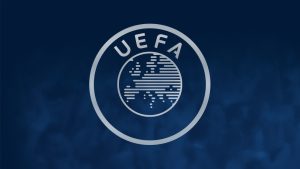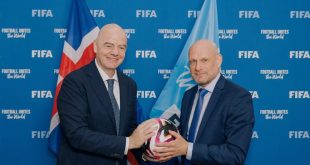 Imagine the scene. The ball arcs high into the penalty area, and, as a mass of bodies jump to meet it, one figure, in a lightly coloured shirt, rises highest to power a header towards goal, outjumping their opponents, also in light jerseys, and beating the goalkeeper, whose outstretched lightly coloured arm can’t keep the ball out of the net.
Imagine the scene. The ball arcs high into the penalty area, and, as a mass of bodies jump to meet it, one figure, in a lightly coloured shirt, rises highest to power a header towards goal, outjumping their opponents, also in light jerseys, and beating the goalkeeper, whose outstretched lightly coloured arm can’t keep the ball out of the net.
For most of us, it is an unthinkable scenario when watching a football match not to be able to distinguish between teams, but for a surprising number of people it is a troubling reality.
Some 320 million people around the world, one in 12 men and one in 200 women, suffer from some form of colour blindness, an inability to perceive colours normally.
It means dozens of matches can cause an issue for colour blind fans due to ‘clashing’ colours worn by opposing teams, while on the pitch, the chances are there is at least one male player in every game who is colour blind. This can present problems when distinguishing between team-mates and opponents in a match, identifying cones or bibs used in training sessions or deciphering the colourful information on tactics boards.
Stars raising awareness
This weekend, prominent players, associations and clubs are getting behind Colour Blind Awareness Day on Sunday 6 September.
Portugal and Manchester United midfielder Bruno Fernandes is an ambassador for the initiative. “Not being able to watch a UEFA Europa League or a Man Utd match on TV in full colour, to help easily distinguish between teams, referee cards and coloured objects in the stands, seems almost unimaginable to me,” he says.
“None of my teammates has identified as colour blind but for sure there are many in football who may face a range of difficulties when playing or watching the game. That’s why it’s so important to raise awareness, provide greater information and make changes so that those who live with colour blindness don’t feel left out and experience the game to the fullest. Football is a universal language and everyone has the right to speak it clearly and confidently.”
Iceland and Everton’s Gylfi Sigurdsson has shared his experience of learning about the impact of colour blindness in football.
“I was at Reading Academy for many years with another colour blind player who went on to play at a Premier League club,” he explains. “At the time we didn’t know [he] was colour blind and I never realised until now how much more challenging training would be for him if we used equipment he couldn’t tell apart. This must have made it much more difficult for him to earn a place in the squad at times.”
Tackling the issue
UEFA helps its member associations work with our partner, Colour Blind Awareness, to help better understand and raise awareness of the issue – be that on the pitch, in the stands or for viewers at home.
Aided by UEFA, Colour Blind Awareness has assembled a collaborative partnership comprising national associations from Iceland, Portugal and Romania, as well as Danish Superliga Club Randers FC, Oxford Brookes University and project manager EFDN (The European Football Development Network) to receive EU Erasmus+ Sport funding.
The project aims to raise awareness of colour blindness in sport across Europe, investigate prevalence of colour blindness in elite sportspeople, identify any barriers to player progression and development of resources to support organisations and individuals.
“In the EU, close to 34 million people have CVD (colour vision deficiency),” explains Colour Blindness Awareness founder Kathryn Albany-Ward, “and failure to acknowledge the difficulties they face in sport risks alienating them in significant numbers, meaning they are likely to turn off TV coverage and take to social media to vent their frustrations.
“So, it’s in sport’s interests to resolve the issues. The good news is that implementing procedures to assist and protect those with colour blindness in sport is relatively simple. Much of the time, all that’s needed is a little goodwill and forward planning, and solutions can have positive benefits for teams, fans, sponsors and broadcasters.
“Colour Blind Awareness Day has been gaining momentum in the last few years, and we are excited to see it come to life this year in partnership with UEFA, the national associations and our TACBIS partners.”
This year, Colour Blind Awareness is working with Iceland, Portugal, Romania and England to put extra focus on raising awareness of colour blindness.
Klara Bjartmarz, Iceland’s general secretary, and the third vice-chairwoman of UEFA’s Football and Social Responsibility committee is happy to be involved.
“Football should be as inclusive as possible, so it is important to raise awareness of an important issue facing many millions of supporters, players and people struggling to engage with the game,” she says.
“We are pleased to work alongside Colour Blind Awareness and our other partners in tackling this issue and will continue to study, learn and help UEFA’s member associations to help make football accessible to everyone.”
Colour Blind Awareness – five tips for kit success
– With regards to kit selection, the more colour combinations there are in a kit the greater the risk of a kit clash occurring, while single colour red, orange or green kits should be avoided if possible.
– A simple way to check if two kits might clash is to imagine how they might appear in greyscale. You can use your smartphone/tablet ‘greyscale’ or ‘mono’ camera settings to check both kits. If they are similar in ‘greyscale’ they are likely to be a ‘colour blind’ kit clash.
– Ideally one team should play in a dark kit and the other in a light kit. Therefore, when selecting new home and away kits, consider choosing one dark kit and one light kit.
– If shirts are patterned, ensure the pattern is on the entire shirt and not just the front or back.
– For training sessions, try to supply both blue and yellow bibs, or one dark colour and one light colour.
 Arunava about Football A look at football & the world through my eyes!
Arunava about Football A look at football & the world through my eyes!



